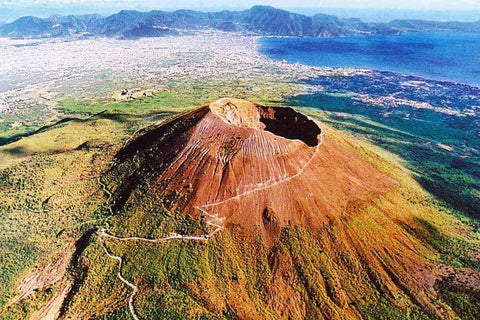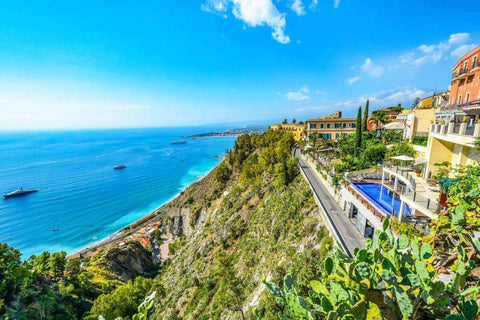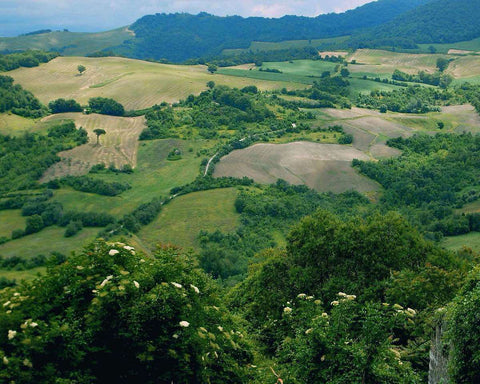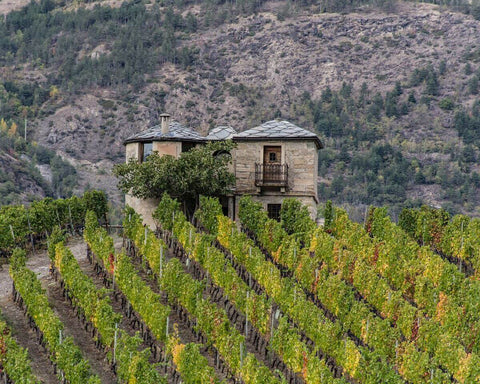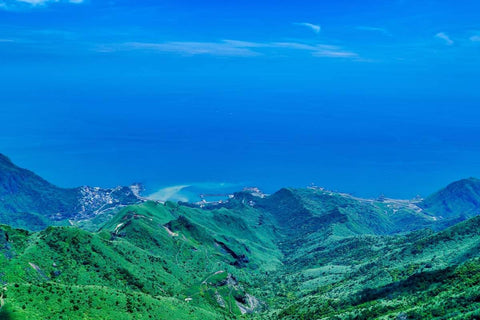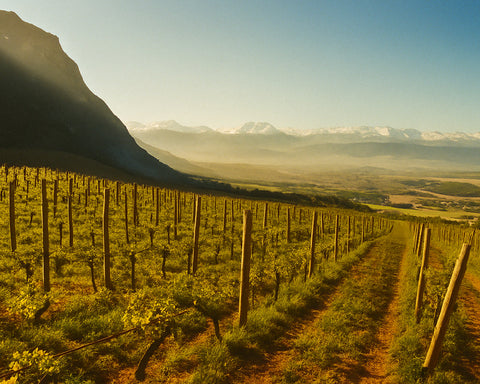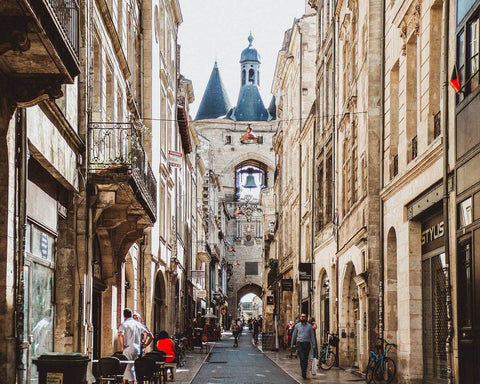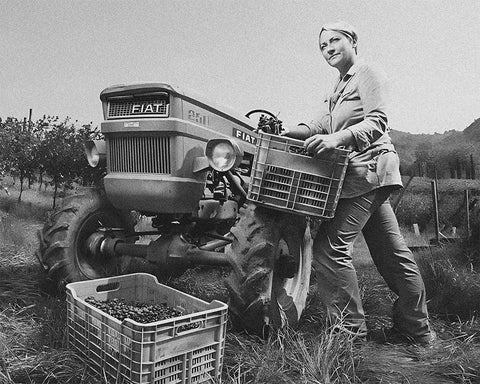Campania, translating to "fertile countryside," is one of Italy's most vibrant and historically rich regions. Nestled along the southwestern coast of Italy, this southern Italian gem is globally revered for its diverse landscapes, producing wines that embody excellence and tradition.
Over the centuries, Campania has emerged as a beacon for organic and natural wine cultivation, with an emphasis on sustainable practices that respect the terroir and the intricate balance of nature.
The wines from Campania are not just beverages; they encapsulate the region's rich history, its commitment to quality, and its passionate pursuit of vinicultural perfection, especially evident in its world-renowned Taurasi and Fiano di Avellino wines.
Table of Contents
History of Campania
Campania, bordered by the Tyrrhenian Sea, has always been a region of strategic significance, both geopolitically and viticulturally. Its history is a rich tapestry of cultures, from the ancient Greeks and Romans to the Normans and Spanish, who recognized the region's potential for wine production.
Over the centuries, Campania underwent numerous transformations, from being a key region in the Roman Empire to playing a pivotal role in the Kingdom of Naples and the Kingdom of the Two Sicilies.
Naples, the regional capital, has been a cultural and economic hub since ancient times. Throughout these historical shifts, one constant remained: Campania's unwavering commitment to producing exceptional wines, a tradition passed down through generations.
The history of winemaking in Campania stretches back to the ancient Greeks, who introduced viticulture to the region in the 8th century BCE. Archaeological evidence suggests that viticulture was well-established in Campania when the Romans arrived in the 2nd-century BCE.
The Romans, known for their winemaking prowess, recognized the potential of Campania's terroir and further developed viticulture in the region. They introduced advanced techniques and expanded the vineyards, laying the foundation for Campania's future as a major wine-producing area.
Following the fall of the Roman Empire, viticulture in Campania, as in much of Europe, was preserved and advanced by monastic orders. Monasteries became centers of agricultural knowledge, and monks meticulously maintained vineyards and documented their winemaking practices. The Benedictine and Cistercian orders, in particular, played a significant role in promoting high-quality viticulture.
During the medieval period, the nobility also began recognizing the value of Campanian wines. They established vineyards and wineries, contributing to the region's reputation for producing fine wines. The House of Bourbon, which ruled Naples, was instrumental in promoting and protecting the region's viticultural interests.
The Renaissance marked a significant turning point in Campania's winemaking history. During this time, the Aglianico grape began to gain prominence. Aglianico, named after the Latin term for "Hellenic" or "Greek," became the cornerstone of Campania's viticulture. The grape thrived in the volcanic soils, producing wines with remarkable complexity and aging potential.
One of the most notable developments during this period was the emergence of Taurasi.
Often referred to as the "Barolo of the South," Taurasi is made exclusively from Aglianico grapes and celebrated for its depth, structure, and longevity. The origins of Taurasi can be traced back to the early 19th century when local winemakers refined the winemaking techniques for Aglianico, transforming it into the powerful wine we know today.
The 19th century was a period of innovation and challenges for Campania's wine industry. On the one hand, the region saw significant advancements in winemaking techniques. The influence of French enologists and the adoption of scientific approaches to viticulture improved the quality and consistency of Campanian wines.
However, this period was also marked by the devastating impact of phylloxera, a vine-killing pest that ravaged European vineyards. Campania was not spared, and many vineyards were destroyed. The crisis prompted a replanting effort, often using American rootstocks resistant to phylloxera, which eventually allowed the region to recover and continue its winemaking traditions.
The early 20th century was challenging for Campania, as it was for many European wine regions. The two World Wars and the economic turmoil that followed significantly impacted viticulture. However, the resilience of Campania's winemakers shone through as they worked to rebuild and rejuvenate their vineyards.
The mid-20th century began a renaissance for Campanian wines. Winemakers began to focus on quality over quantity, adopting modern techniques while respecting traditional methods. This period saw the rise of notable wine families and estates, such as Mastroberardino, who played pivotal roles in elevating the status of Campania's wines on the global stage.
In recent decades, Campania has firmly established itself as one of the world's premier wine regions. The region's commitment to quality, combined with its unique terroir, has earned it a place among the elite wine-producing areas of the world.
The appellation system, introduced in the 1960s, further cemented Campania's reputation. Creating DOC (Denominazione di Origine Controllata) and DOCG (Denominazione di Origine Controllata e Garantita) classifications helped protect and promote the region's wines. Taurasi and Fiano di Avellino were among the first to receive DOCG status, underscoring their significance.
Terroir of Campania
Campania's terroir is characterized by its unique interplay of climate, topography, and soil. The region enjoys a Mediterranean climate, with mild winters and hot summers, moderated by the cooling influence of the Tyrrhenian Sea.
The hilly and volcanic terrain, particularly in areas like Irpinia and the Amalfi Coast, provides an optimal setting for vineyards, ensuring ample sunlight and drainage. The soil composition varies, ranging from volcanic and sandy in areas like Vesuvio to more clayey and limestone-rich soils in Irpinia.
This diverse terroir lends itself to cultivating many grape varieties, each expressing a unique facet of the region's multifaceted character.
The Geology of Campania
Campania's landscape predominantly comprises coastal plains, rolling hills, and volcanic mountains, with elevations ranging from sea level to over 1,000 meters above sea level. The region is divided into several sub-regions, each with unique geological characteristics. The primary wine-producing areas include Irpinia, Sannio, and the Amalfi Coast, each contributing distinct terroir profiles.
- Irpinia: Known for its clay and limestone soils, it provides excellent drainage, essential for growing high-quality grapes. The region is famed for Aglianico, the grape behind Taurasi, which thrives in the well-drained soils and benefits from the area's significant diurnal temperature variation.
- Sannio: Characterized by calcareous and clay soils, Sannio is slightly cooler than other areas. These conditions are ideal for the white grape Falanghina, which produces aromatic and fresh wines.
- Amalfi Coast: This area features a mix of volcanic and sandy soils. The Amalfi Coast is well-known for its Biancolella and Fenile grapes, producing aromatic white and sweet dessert wines.
The region's geological diversity ensures that each grape variety can match its optimal soil type, enhancing the grapes' expression and complexity.
Climate and Its Influence
Campania's climate is Mediterranean, characterized by hot summers and mild winters, with significant temperature variation between day and night. This diurnal range is crucial for grape ripening, allowing the development of sugars during the day and preserving acidity at night. The region's microclimates, influenced by the surrounding sea and mountains, further contribute to the distinctiveness of Campania wines.
The Grapes of Campania
Campania has several indigenous grape varieties, each adapted to the region's unique terroir. The most notable are Aglianico, Greco, Fiano, and Falanghina.
Red Grape Varietals
- Aglianico: The cornerstone of Campania's most celebrated wines, such as Taurasi.
- Piedirosso: Widely planted and known for its soft tannins and fruity flavors.
- Sciascinoso: Produces early-drinking wines with soft tannins and fruity flavors.
- Casavecchia: Known for its spicy and tannic wines.
- Palagrello Nero: Produces light, aromatic wines with notable acidity.
- Barbera del Sannio: Aromatic with floral and spicy notes, primarily in Sannio.
- Tintore: Used for still and sparkling sweet red wines, such as Tintore di Tramonti.
White Grape Varietals
- Fiano: Known for producing aromatic and crisp wines, primarily in Avellino.
- Greco: The grape behind Greco di Tufo wines, known for its acidity and minerality.
- Falanghina: Used to make the famous Falanghina wines.
- Biancolella: Similar to Vermentino, used in fresh and aromatic wines.
- Coda di Volpe: Known for its high acidity and potential for sparkling and sweet wines.
- Asprinio: Used both in still wines and for sparkling wine production.
- Fenile: Produces aromatic and crisp wines.
- Ginestra: Cultivated in small quantities, used for aromatic white wines.
- Ripolo: Often used in sweet and aromatic wines.
Top Wines of Campania
Taurasi: Often referred to as the "Barolo of the South," Taurasi is a testament to Campania's vinicultural prowess. Made from the Aglianico grape, Taurasi is characterized by its deep ruby hue, complex blackberries, cherries, and spices aromas, and an aging potential rivaling the world's finest wines.
The wine undergoes extended aging, first in large oak barrels and then in the bottle, resulting in profound depth, structure, and elegance.
Fiano di Avellino: Fiano di Avellino, while sharing many similarities with other white wines, has its distinct identity. Crafted from the Fiano grape, Fiano di Avellino wines are known for their finesse and aromatic complexity.
The terroir of Avellino's volcanic soils imparts a certain elegance to the wines, with notes of white flowers, citrus, and almonds. While Fiano di Avellino undergoes a shorter aging process compared to Taurasi, it still produces wines of remarkable complexity and longevity.
Other Notable Wines: While Taurasi and Fiano di Avellino are undoubtedly the crown jewels of Campania, the region is also home to other notable wines like Greco di Tufo, Falanghina, and Lacryma Christi del Vesuvio. Greco di Tufo, known for its bright acidity and minerality, is a versatile wine that pairs well with various dishes.
Falanghina, with its fresh and aromatic profile, is perfect for everyday drinking. Lacryma Christi del Vesuvio, a slightly sparkling sweet wine, is known for its fragrant floral and fruit aromas, making it a favorite dessert wine.
Cuisine and Typical Products of Campania
Campania's culinary landscape is as intricate and refined as its wines. The region is famed for its rich and hearty dishes, emphasizing local and seasonal ingredients.
Buffalo mozzarella, particularly the Mozzarella di Bufala Campana, holds a place of honor in Campanian cuisine. Dishes like "Pizza Margherita," topped with fresh mozzarella, tomatoes, and basil, capture the essence of Campania on a plate. Pastas, often paired with fresh seafood or rich tomato sauces, showcase the region's affinity for pasta dishes.
Campania is also known for its desserts, with iconic sweets like sfogliatella, babà, and pastiera being some of the notable varieties. The culinary traditions of Campania and its exceptional wines offer a gastronomic journey that resonates with the region's rich heritage and passion for excellence. Let's dive deep into Campania's cuisine and typical products
Campanian Antipasti
In Campania, a meal often starts with a selection of antipasti. These appetizers showcase the region's diverse flavors and set the stage for future courses. A typical antipasti spread might include:
- Mozzarella di Bufala: Fresh buffalo mozzarella, often served with tomatoes and basil.
- Parmigiana di Melanzane: Layers of fried eggplant, tomato sauce, and cheese, baked to perfection.
- Insalata di Mare: A seafood salad made with fresh octopus, shrimp, and calamari.
- Baccalà alla Napoletana: Salt cod cooked with tomatoes, olives, and capers.
Campanian Primi Piatti (First Courses)
The first course in a Campanian meal often features pasta, risotto, or hearty soups. These dishes showcase the region's grains, rice, and seasonal vegetables.
- Spaghetti alle Vongole: Spaghetti with clams, garlic, and white wine.
- Paccheri al Ragù: Large pasta tubes served with a rich meat sauce.
- Risotto alla Pescatora: A seafood risotto with shrimp, mussels, and calamari.
- Gnocchi alla Sorrentina: Potato dumplings baked with tomato sauce and mozzarella.
Campanian Secondi (Second Courses)
Campania is known for its high-quality meats and seafood. The second course often highlights these prized ingredients, prepared with local herbs and spices.
- Braciola di Maiale: Pork chops cooked with tomatoes and herbs .
- Polpette al Sugo: Meatballs in a rich tomato sauce.
- Pesce Spada alla Siciliana: Swordfish cooked with tomatoes, olives, and capers.
- Frittura di Paranza: A mixed fry of small fish and seafood served with lemon.
Campanian Contorni (Side Dishes)
Campanian cuisine doesn't neglect vegetables. Many side dishes and salads highlight the region's produce.
- Friarielli: Sautéed broccoli rabe with garlic and chili flakes.
- Zucchine alla Scapece: Fried zucchini marinated in vinegar, mint, and garlic.
- Insalata Caprese: Fresh tomatoes, mozzarella, and basil, drizzled with olive oil.
Campanian Formaggi (Cheeses)
Campania produces some of Italy's most renowned cheeses. A cheese course often follows the main dishes.
- Mozzarella di Bufala Campana: The king of Campanian cheeses made from buffalo milk.
- Provolone del Monaco: A semi-hard cheese with a sharp, tangy flavor.
- Caciocavallo Silano: A stretched-curd cheese with a smooth texture and mild flavor.
Campanian Dolci (Desserts)
Campanian desserts often feature local nuts, citrus, and seasonal fruits.
- Sfogliatella: A pastry filled with sweet ricotta, candied fruit, and semolina.
- Babà: A rum-soaked sponge cake, often served with whipped cream or fruit.
- Pastiera Napoletana: A ricotta and wheat berry pie flavored with orange blossom water.
- Delizia al Limone: A lemon-flavored sponge cake filled with lemon cream.
Typical Products of Campania
Campania's cuisine is based on high-quality local products. Many of these have achieved protected status, ensuring authenticity and traditional production methods.
Buffalo Mozzarella: Campania's Treasure
The Mozzarella di Bufala Campana, also known as the "Queen of the Mediterranean cuisine," is considered one of the finest mozzarella in the world. This cheese is prized for its delicate flavor and is used in many sweet and savory dishes. It's also a key ingredient in traditional pizzas and salads.
Olive Oil: Liquid Gold
Campania is one of Italy's major olive oil-producing regions. This area's extra virgin olive oil is known for its high quality.
Tomatoes: From the Plains to the Plate
Campania produces a wide variety of tomatoes, each reflecting the characteristics of its production area.
- San Marzano DOP: Known for its sweet flavor and low acidity, perfect for sauces.
- Pomodorino del Piennolo del Vesuvio DOP: Small, sweet cherry tomatoes grown in the volcanic soils around Mount Vesuvius.
- Pomodorino Giallo del Vesuvio: A yellow cherry tomato with a sweet, tangy flavor.
Meat and Charcuterie
Campanian meat products are known for their quality and distinctive flavors.
- Salsiccia di Napoli: A dry-cured sausage flavored with fennel seeds and chili.
- Capocollo di Martina Franca: A cured pork neck known for its delicate flavor.
- Salame Napoli: A salami characterized by its coarsely ground meat and mild flavor.
Fruits and Vegetables
Campania's varied climate allows for cultivating a wide range of produce.
- Lemons of Sorrento: Known for their thick skin and intense aroma, used in Limoncello production.
- Peaches of Campania: Sweet and juicy, often used in desserts.
- Broccoli Rabe: A bitter green usually sautéed with garlic and olive oil.
